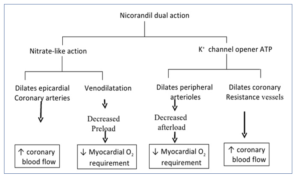- Nicorandil is vasodilator drug used mainly to treat chest pain caused due to angina. It is nicotinamide ester which has a nitric oxide like action.
- Nicorandil belongs to class of non-selective adenosine-sensitive potassium channel activators. It was approved for medical use in 1983.
- It is not an approved drug by FDA.
Indications of Nicorandil
- In Angina pectoris. It has been approved for long term therapy of chronic stable angina and is used as alternative in patients who cannot tolerate nitrates and beta-blockers. It can be used in presence of asthma or cardiac failure.
- Effective in re-perfusion induced damage following coronary angioplasty or thrombolysis.
- In acute coronary syndrome.
Mechanism of action of Nicorandil

Figure- Mechanism of action of Nicorandil
- It has a dual mechanism of action. It acts as potassium channel activator and nitric oxide (NO) donor.
- Potassium channels play important role in regulation of membrane potential and excitability of cells. Nicorandil binds with ATP- sensitive potassium (KATP) channel and open them, causing potassium ions to leak from the cell. This causes hyperpolarization and stabilization of cell membrane of vascular smooth muscle, reduces calcium entry and prevents vasoconstriction leading to relaxation. Thus, it acts as arterial vasodilator.
- It also facilitates release of NO leading to increased cGMP level, with reduction in intracellular calcium and vascular smooth muscle cell relaxation.
- It dilates normal and stenotic coronary arteries and reduces both ventricular pre-load and after load.
Pharmacokinetics of Nicorandil
- It is rapidly and completely absorbed after oral administration.
- It is absorbed 30-45 minutes after oral ingestion with minimal first-pass metabolism in liver and hence show high bioavailability.
- Protein binding is minimum and most of the drug circulates in unbound from. Maximum plasma concentration is achieved within 60 minutes of oral ingestion.
- It is metabolized in liver by de-nitration to form inactive N-(2-hydroxyethyl) nicotinamide, and reduction of the alkyl chain, leading to nicotinamide/nicotinic acid.
- Most of the metabolites are eliminated in urine. About 1% of dose is excreted unchanged in urine and fecal excretion accounts for about ˂ 2%.
Adverse Effects
- Common side effects may occur due to vasodilator action and includes headache, dizziness and dose dependent hypotension. It can also cause nausea, vomiting, rectal bleeding and tachycardia at high doses.
- Oral ulceration, intestinal, anal, corneal and skin ulceration may occur rarely. Nicorandil induced oral ulceration is accompanied by weight loss because of anorexia due to discomfort and dysphagia.
Drug Interaction
- Concurrent administration with aspirin, corticosteroids, prednisolone may increase risk of asverse effects.
- Drugs like alfuzosin, alprenolol, trimethaphan and quinine increase hypotensive activities of nicorandil.
- It enhance hypotensive activities of drug like verapamil, torasemide, tolcapone, spironolactone and propranolol.
Contraindication
It is not used in following conditions:
- In patients allergic to nicorandil.
- In pregnancy and breast-feeding mothers.
- Acute pulmonary edema.
- Cardiogenic shock.
- In left ventricular failure.
- In hypotensive patients.
References
- Samra K, Manikam L, Pathmakanthan S. When treatment can be worse than the disease: nicorandil-induced colitis. BMJ Case Rep. 2015; bcr2015209799: 1-4.
- K Webster, P Godbold. Nicorandil induced oral ulceration. British Dental Journal. 2005; 198: 619-621.
- Zhao XT, Zhang CF, Liu QJ. Meta-analysis of Nicorandil effectiveness on myocardial protection after percutaneous coronary intervention. BMC Cardiovascular Disorders. 2019; 19 (144): 1-10.
- Pisano U, Deosaran J, Leslie SJ, Rushworth GF, Stewart D, Angus IF, Watson JM. Nicorandil, Gastrointestinal Adverse Drug Reactions and Ulcerations: A Systematic Review. Advances in Therapy. 2016; 33: 320-344.
- Ahmed LA. Nicorandil: A drug with ongoing benefits and different mechanisms in various diseased conditions. Indian Journal of Pharmacology. 2019; 51(5): 296-301.
- https://pubchem.ncbi.nlm.nih.gov/compound/nicorandil
- Pharmacology and pharmacotherapeutics. 24th edition.